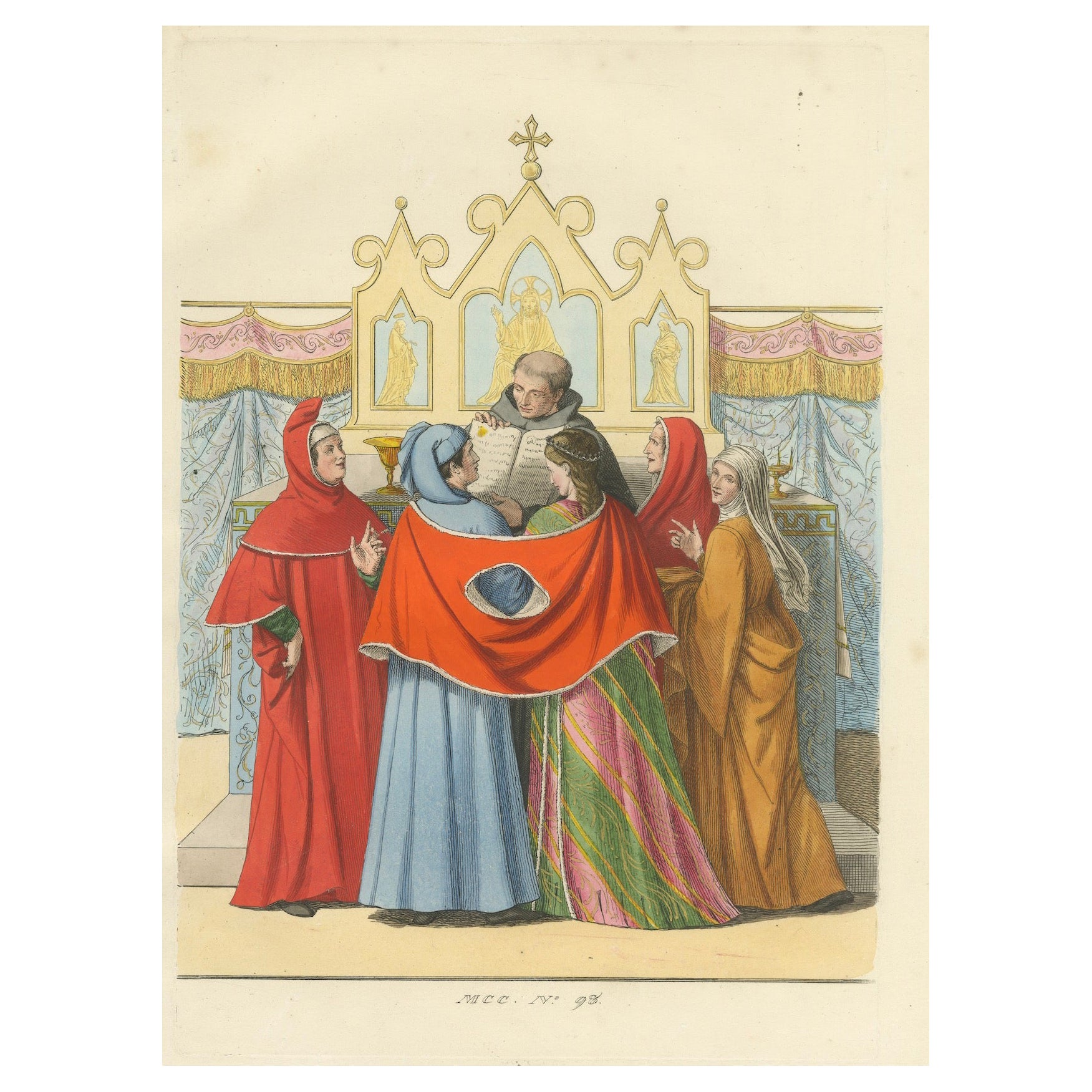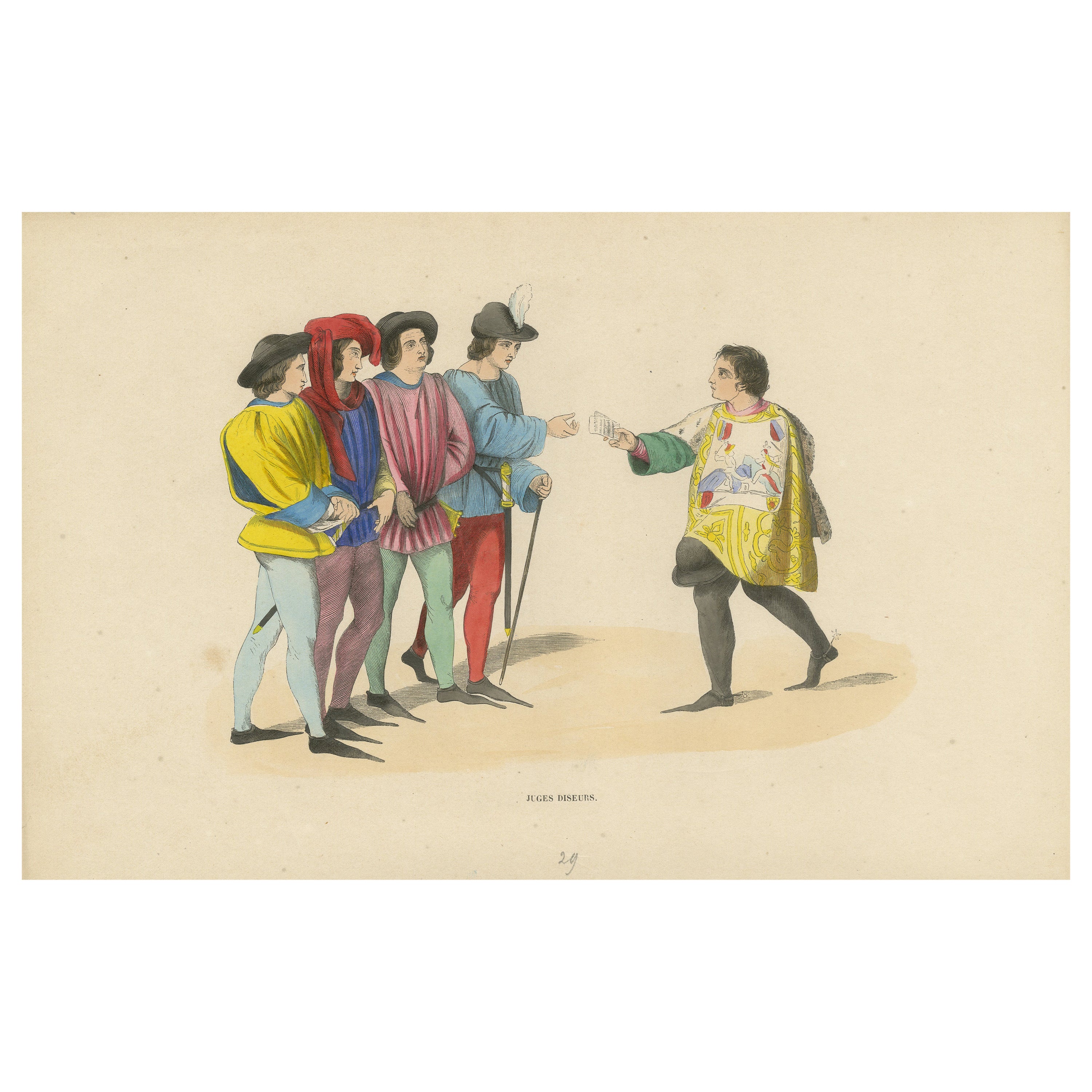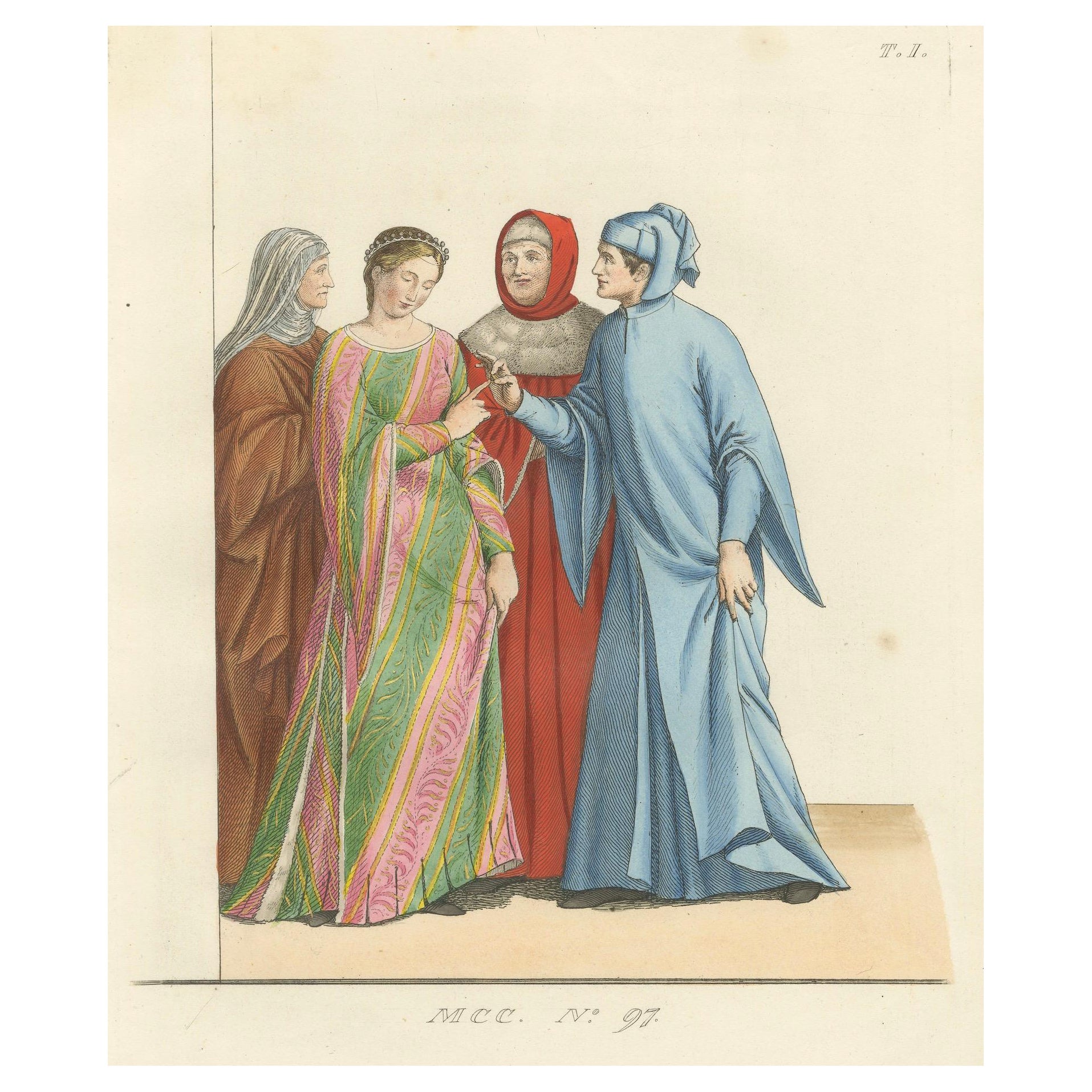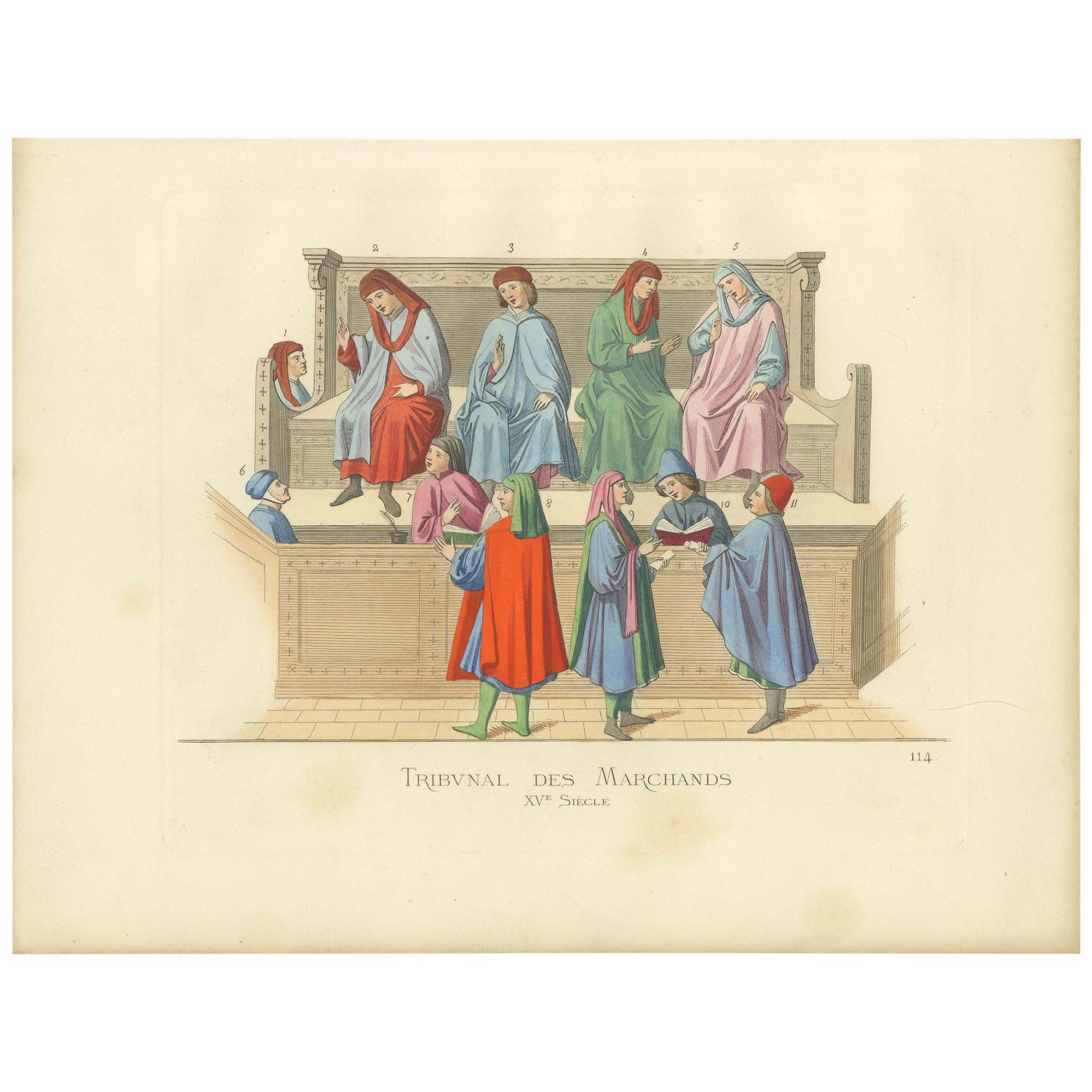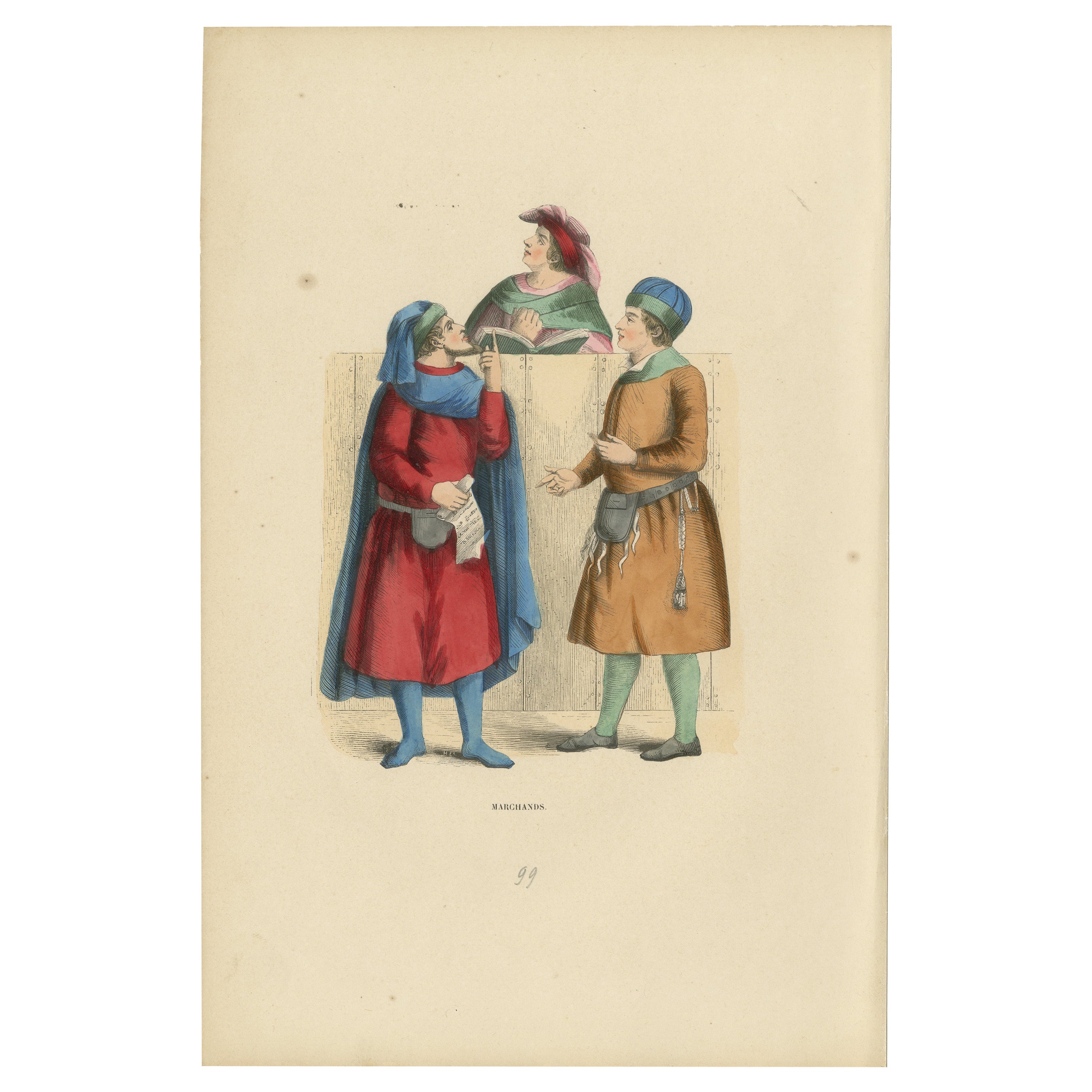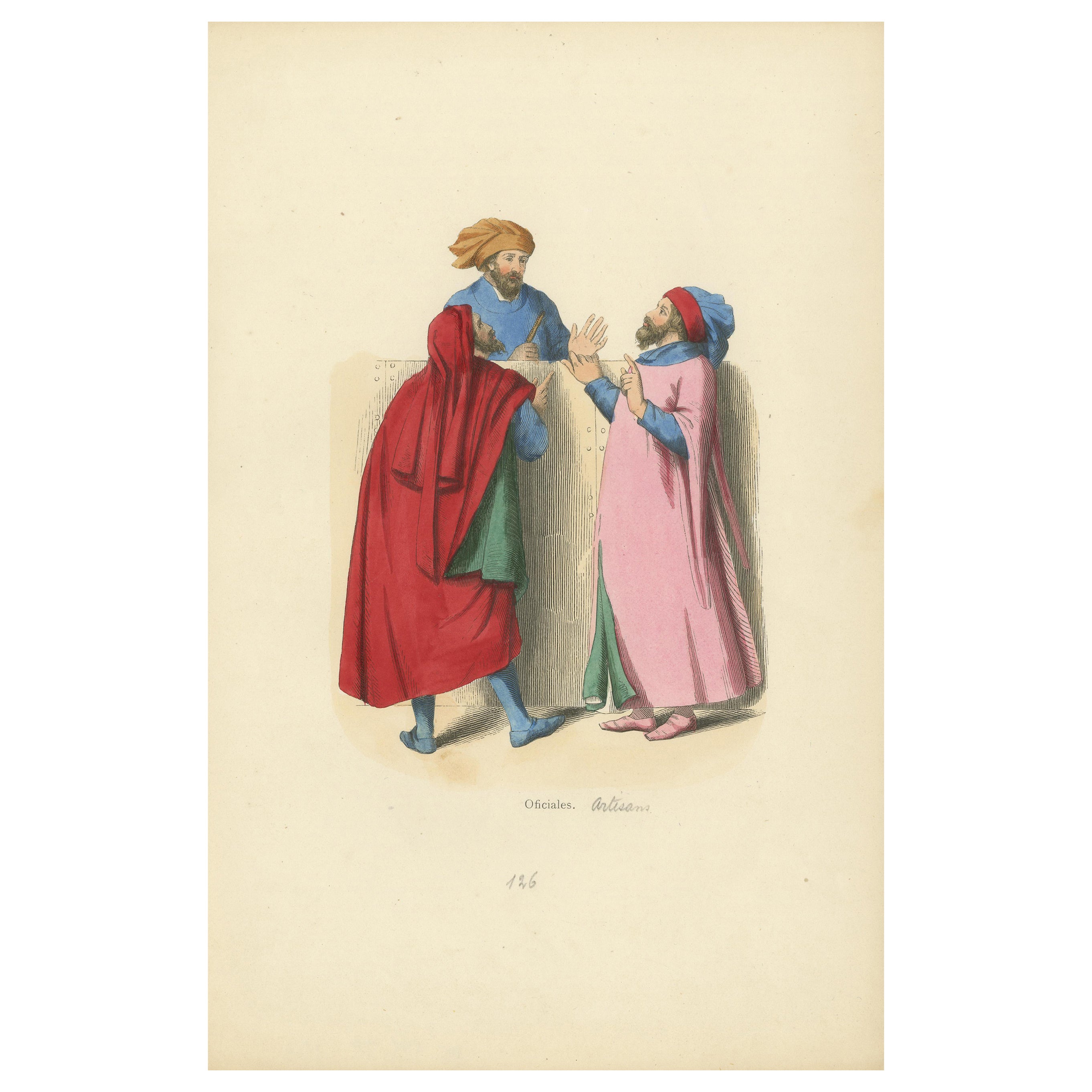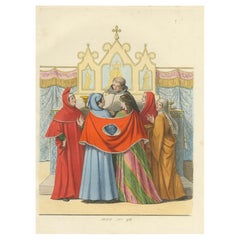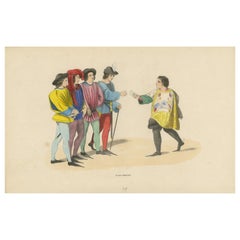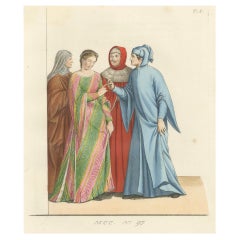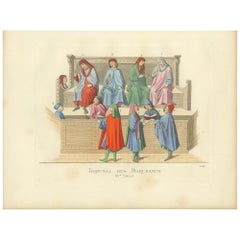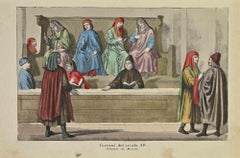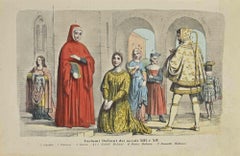Articles similaires à Scène de tribunal de marchands avec des consuls et des pétitionnaires dans l'Italie médiévale, 1845
Vous voulez plus d'images ou de vidéos ?
Demander au vendeur plus d'images ou de vidéos
1 sur 10
Scène de tribunal de marchands avec des consuls et des pétitionnaires dans l'Italie médiévale, 1845
260 €TVA incluse
À propos de cet article
Title:
Merchant Courtroom Scene with Consuls and Petitioners in Medieval Italy
Description:
This elegant hand-colored lithograph titled “Tribunal des Marchands” (Merchant’s Court) is plate No. 47 from the 1845 edition of *Costumes Historiques des XIIIe, XIVe et XVe Siècles*. Designed by Paul Mercuri and historically annotated by Camille Bonnard, the image is a faithful reproduction of a miniature attributed to Sano di Pietro, taken from a manuscript of the *Statuts des marchands* preserved in the library of Siena. It offers a vivid reconstruction of the commercial justice system in place in the free trading cities of late medieval Italy.
The illustration presents a structured, hierarchical courtroom scene in which merchant consuls preside from an elevated bench. Seated in solemn robes, the five judges are depicted with differing garments and headdresses, reflecting their status and individual identities. According to the original text, the consuls wear robes and hoods in a range of symbolic colors—red, blue, violet, and green—each combination carefully described in the original legend and visible in the detailed coloring of the print.
Beneath the consuls, the lower half of the tribunal shows scribes, petitioners, and merchants in active dialogue. They are depicted exchanging documents, consulting one another, or presenting their cases. Each figure’s attire is rendered with precision: from green tunics trimmed in white, to orange mantles, to scarlet hoods and black shoes. These details are historically accurate and serve not only to illustrate costume but to distinguish roles within the institutional structure of medieval commerce.
The accompanying commentary explains that such courts were essential to the governance of trade in free cities like Pisa, Genoa, Venice, and Amalfi. The consuls of merchants had far-reaching powers, judging disputes, enforcing contracts, and even negotiating with foreign powers. This print is more than a depiction of fashion—it is a window into the civic mechanisms that underpinned economic growth and legal order in the medieval Mediterranean world.
The numbered figures in the print "Tribunal des Marchands" (Plate No. 47 from *Costumes Historiques des XIIIe, XIVe et XVe Siècles*, 1845) correspond to the following individuals as described in the original text:
Fig. 1 – A merchant who has approached the consuls to speak. He wears a red chaperon (hood), and the visible part of his clothing is blue.
Fig. 2 – A consul or magistrate wearing a scarlet chaperon. His robe is the same color, his mantle is a changing blue with violet tones, and his shoes are black.
Fig. 3 – This figure wears a scarlet bonnet. Both the mantle and the robe are blue, with the robe bordered by a white trim. The undergarment is lacquer red, and the shoes are black.
Fig. 4 – This figure has a scarlet chaperon, a greenish robe, and black shoes.
Fig. 5 – The chaperon and sleeves are blue, the mantle is lacquer red, and the shoes are black.
Fig. 6 – This figure wears a blue veil, with a white band passing under the chin. It appears to represent a scribe or a person involved in documentation.
Fig. 7 – This figure has a black chaperon. The rest of the clothing is lacquer-colored, and the book binding is green.
Fig. 8 – The chaperon and the chausses (leggings) are greenish. The tunic is blue, and the mantle is orange.
Fig. 9 – The chaperon is lacquer red, the mantle and chausses are greenish, the tunic is light blue shifting into violet, and the boots are black.
Fig. 10 – The bonnet is blue, the tunic is lead-colored, and the book binding is red.
Fig. 11 – The bonnet is scarlet, the mantle is light blue shifting into violet, the tunic is greenish with white trim, and the shoes are black.
These descriptions correspond directly to the clothing details depicted in the image, offering a well-documented view of commercial, legal, and civic dress in late medieval Italy.
Condition:
Very good condition. The sheet is clean with only light age-related spots in the margins. Hand-coloring is fresh and well-preserved, with all details clearly visible. No tears or losses.
Framing Tips:
Use a medium to dark wooden frame—walnut or cherry—for a scholarly, classic presentation. A double mat in ivory and burgundy or slate blue would complement the color palette and enhance the historic feel. Ideal for display in a study, office, or library focused on legal, commercial, or medieval themes.
- Dimensions:Hauteur : 22,3 cm (8,78 po)Largeur : 30,3 cm (11,93 po)Profondeur : 0,2 mm (0,01 po)
- Matériaux et techniques:Papier,Gravé
- Lieu d'origine:
- Période:
- Date de fabrication:1845
- État:Very good condition. The sheet is clean with only light age-related spots in the margins. Hand-coloring is fresh and well-preserved, with all details clearly visible. No tears or losses.
- Adresse du vendeur:Langweer, NL
- Numéro de référence:Vendeur : BG-14024-171stDibs : LU3054345400552
À propos du vendeur
5,0
Vendeur reconnu
Ces vendeurs prestigieux sont des leaders du secteur. Ils représentent le summum en matière de qualité et de design.
Vendeur Platine
Vendeurs premium dont la note est supérieure à 4,7 et le délai de réponse de 24 heures maximum
Établi en 2009
Vendeur 1stDibs depuis 2017
2 641 ventes sur 1stDibs
Temps de réponse habituel : <1 heure
- ExpéditionRecherche du devis...Expédition depuis : Langweer, Pays-Bas
- Politique des retours
Certaines parties de cette page ont été traduites automatiquement. 1stDibs ne garantit pas l'exactitude des traductions. L'anglais est la langue par défaut de ce site web.
Garantie d'authenticité
Bien qu'il soit peu probable que la situation se présente, dans le cas où vous rencontreriez un problème d'authenticité d'un article, contactez-nous dans un délai d'un an pour obtenir un remboursement intégral. DétailsGarantie de remboursement
Si votre article n'est pas conforme à la description, est endommagé pendant le transport ou ne vous est pas livré, contactez-nous sous 7 jours pour obtenir un remboursement intégral. DétailsAnnulation sous 24 heures
Vous disposez d'un délai de 24 heures pour annuler votre achat sans motif.Des vendeurs professionnels agréés
Nos vendeurs de renommée mondiale doivent respecter des normes strictes en matière de service et de qualité, afin de préserver l'intégrité de nos fiches produit.Garantie d'alignement des prix
Si vous constatez qu'un autre vendeur a mis en vente le même article à un prix inférieur sur un autre site, nous nous alignerons sur ce prix.Livraison en toute confiance à l'international
Notre réseau de transporteurs de premier ordre propose des options d'expédition spécialisées dans le monde entier, y compris des livraisons personnalisées.Plus d'articles de ce vendeur
Tout afficherMariage italien du 14e siècle - Clergé et noblesse dans une estampe ancienne, 1845
Titre : Cérémonie de mariage italienne médiévale avec le clergé et la noblesse, 1845
Cette exquise gravure coloriée à la main, publiée en 1845 dans la célèbre série Costumes histori...
Catégorie
Antiquités, Milieu du XIXe siècle, Français, Estampes
Matériaux
Papier
Laclamation : juges de la cour médiévale dans une lithographie originale, 1847
L'image représente un groupe d'hommes étiquetés "Juges Diseurs", ce qui se traduit par "Juges orateurs" ou "Juges parlants". Ce terme pourrait désigner les fonctionnaires chargés de ...
Catégorie
Antiquités, années 1840, Estampes
Matériaux
Papier
128 € Prix de vente
20 % de remise
Courtisanerie médiévale italienne c.1300s - Nobles en habits historiques, estampe 1845
Titre : Scène de parade nuptiale italienne avec des nobles vêtus de vêtements éclatants du 14e siècle, 1845
Cette magnifique gravure coloriée à la main, tirée de la publication Cost...
Catégorie
Antiquités, Milieu du XIXe siècle, Français, Estampes
Matériaux
Papier
Impression ancienne d'un tribunal de marchands, Italie, 15e siècle, par Bonnard, 1860
Gravure ancienne intitulée "Tribunal des Marchands, XVe siècle" Gravure ancienne originale d'un tribunal marchand, Italie, XVe siècle. Cette gravure provient de "Costumes historiques...
Catégorie
Antiquités, Milieu du XIXe siècle, Estampes
Matériaux
Papier
120 € Prix de vente
20 % de remise
Merchants français dans le commerce médiéval, gravure ancienne d'origine de 1847
Titre : "Les marchands médiévaux dans le discours".
Description : Cette estampe colorée est intitulée "Marchands", ce qui suggère qu'elle représente une scène de marchands du Moyen ...
Catégorie
Antiquités, années 1840, Estampes
Matériaux
Papier
112 € Prix de vente
20 % de remise
Le cours médiéval : un moment entre les officiels ou les artistes, publié en 1847
Titre : "Le discours médiéval : Un moment entre officiels dans 'Costume du Moyen Âge'"
Description : Cette vibrante lithographie, extraite de la publication "Costume du Moyen Âge" d...
Catégorie
Antiquités, années 1840, Estampes
Matériaux
Papier
112 € Prix de vente
20 % de remise
Suggestions
Costumes du 14e siècle - Lithographie - 1862
Costumes du XIVe siècle est une lithographie sur papier réalisée en 1862.
L'œuvre appartient aux Us et coutumes de tous les peuples de l'univers : "Histoire du gouvernement, des loi...
Catégorie
années 1860, Moderne, Estampes - Figuratif
Matériaux
Lithographie
Costumes de la Cour d'Angleterre dans les... - Lithographie d'Auguste Wahlen - 1844
Costumes de la cour d'Angleterre au XVe siècle est une lithographie réalisée par Auguste Wahlen en 1844.
Coloré à la main.
Bon état.
Au centre de l'œuvre figure le titre original ...
Catégorie
années 1840, Moderne, Estampes - Figuratif
Matériaux
Lithographie
Costumes italiens des 13e et 14e siècles - Lithographie - 1862
Costumes italiens des XIIIe et XIVe siècles est une lithographie sur papier réalisée en 1862.
L'œuvre appartient aux Us et coutumes de tous les peuples de l'univers : "Histoire du g...
Catégorie
années 1860, Moderne, Estampes - Figuratif
Matériaux
Lithographie
Utilisations et douanes - 11e et 14e Toscane - Lithographie - 1862
Us et coutumes - 11e et 14e Toscane est une lithographie sur papier réalisée en 1862.
L'œuvre appartient aux Us et coutumes de tous les peuples de l'univers : "Histoire du gouvernem...
Catégorie
années 1860, Moderne, Estampes - Figuratif
Matériaux
Lithographie
Costumes de la Cour de France sous... - Lithographie d'Auguste Wahlen - 1844
Costumes de la cour de France sous François Ier est une lithographie réalisée par Auguste Wahlen en 1844.
Coloré à la main.
Bon état.
Au centre de l'œuvre figure le titre original...
Catégorie
années 1840, Moderne, Estampes - Figuratif
Matériaux
Lithographie
Utilisations et douanes - Roi d'Italie - Lithographie - 1862
Us et coutumes - Roi d'Italie est une lithographie sur papier réalisée en 1862.
L'œuvre appartient aux Us et coutumes de tous les peuples de l'univers : "Histoire du gouvernement, d...
Catégorie
années 1860, Moderne, Estampes - Figuratif
Matériaux
Lithographie
